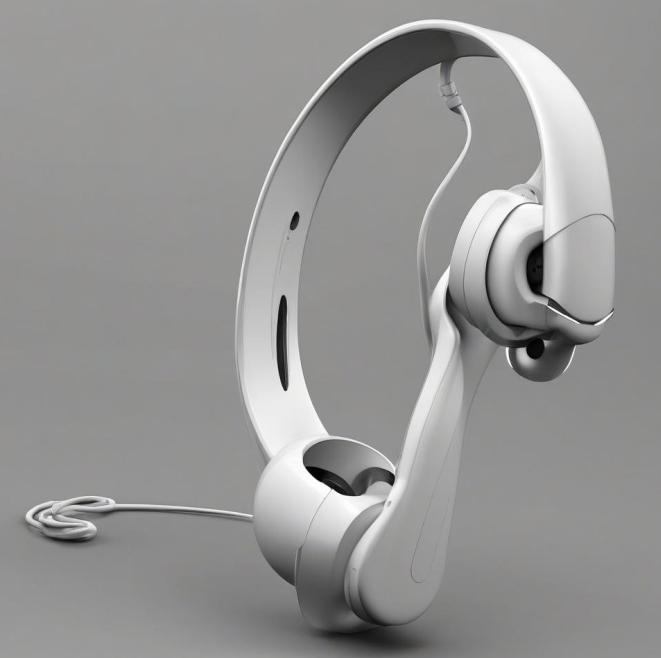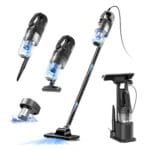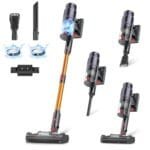Vacuum cleaners can be noisy. Understanding how to reduce this noise is key.
Vacuum noise reduction technology has come a long way. Gone are the days when vacuuming meant enduring a loud, annoying sound. Engineers have worked tirelessly to make vacuums quieter without sacrificing performance. This innovation enhances your cleaning experience by making it more pleasant.
Imagine cleaning your home without disturbing your family or neighbors. This blog will explore the fascinating world of vacuum noise reduction technology. We’ll uncover how it works and why it’s a game-changer for modern living. Get ready to learn how you can enjoy a quieter, more peaceful home.

Credit: www.amazon.com
Introduction To Vacuum Noise
Vacuum cleaners are essential for keeping our homes clean. They help maintain a healthy environment. But, the noise they produce can be quite bothersome. Understanding vacuum noise is the first step to finding solutions. This noise can disrupt our daily lives in many ways.
Impact On Daily Life
Vacuum noise can affect our routines. It can wake up sleeping babies. It can interrupt phone calls and meetings. The loud sound can cause stress and discomfort. Pets often get scared and hide. This noise can be especially disturbing in small apartments. It can even disturb neighbors. A quieter vacuum can make a big difference.
Need For Quieter Solutions
The demand for quieter vacuums is growing. People seek peaceful living environments. Companies are developing noise reduction technologies. These solutions aim to reduce the vacuum’s sound. They use better materials and design. Quieter vacuums are now more accessible. Choosing a quieter vacuum can improve your quality of life. You can clean without the loud noise. It benefits everyone in your household.
Sources Of Vacuum Noise
Vacuum cleaners are essential tools in homes. Yet, they often create a lot of noise. Understanding the sources of vacuum noise can help in reducing it. Below are the main sources of vacuum noise.
Motor Noise
The motor is the heart of the vacuum cleaner. It drives the suction power. Unfortunately, it is also a major noise source. The motor’s vibrations cause a loud hum. This hum can be disruptive in quiet homes. Newer models aim to reduce motor noise. Manufacturers use sound-dampening materials around the motor. This helps in lowering the noise levels.
Airflow Turbulence
Airflow turbulence is another key noise source. As air moves through the vacuum, it creates turbulence. This turbulence causes a loud whooshing sound. The design of the vacuum can impact this noise. Smoother airflow paths reduce turbulence. Better filters and seals also help. By improving airflow design, noise levels can drop significantly.
Technological Advances
Vacuum noise reduction technology helps create quieter environments by minimizing unwanted sounds. This innovation enhances comfort in homes and workplaces. It uses advanced materials and engineering to achieve effective noise control.
### Technological AdvancesVacuum noise can be quite annoying, especially if you like to clean early in the morning or late at night. Fortunately, the latest technological advances have made a significant difference in reducing vacuum noise. From innovative noise dampening materials to quieter motor designs, let’s dive into how these advancements are making your cleaning experience more peaceful.### Noise Dampening MaterialsManufacturers are now using special materials to absorb and reduce noise. These materials are often placed around the motor and other noisy components. For instance, sound-absorbing foam or rubber can be used to encase the motor, significantly lowering the noise levels.I remember the first time I noticed this difference. My old vacuum sounded like a jet engine, but the new one was so quiet that I could hold a conversation while vacuuming. It was a game changer.Have you ever tried vacuuming while someone is on a video call in the same room? With these noise dampening materials, that’s no longer an issue. You won’t have to worry about disturbing others in your home.### Quieter Motor DesignsThe motor is the heart of a vacuum, and traditionally, it has been the main source of noise. Newer models feature quieter motor designs that operate more efficiently. These motors are engineered to produce less noise without compromising on suction power.Think about the last time you used a loud vacuum. It probably left you with a headache. The latest quieter motors are designed to prevent that, making your cleaning sessions more enjoyable.Moreover, these motors consume less energy. That means you not only get a quieter vacuum but also save on your electricity bill. It’s a win-win situation.So, next time you’re in the market for a new vacuum, consider one with these advanced features. Your ears and your household will thank you.
Credit: www.in3dtec.com
Innovative Noise Reduction Features
Vacuum noise reduction technology uses advanced materials and soundproofing techniques. These features help reduce the loud sounds made by vacuums. Enjoy a quieter cleaning experience.
Innovative noise reduction features in vacuum cleaners have transformed our daily cleaning routines. These features ensure a quieter operation, allowing you to vacuum without disturbing your peace or others around you. Let’s explore some of the key aspects of this technology.###Sound Insulation
Sound insulation is a game-changer in reducing vacuum noise. By using materials that absorb sound, vacuums can operate more quietly. Think of it as wearing noise-canceling headphones but for your vacuum.Manufacturers use dense foam and rubber to dampen the noise. The motor, which is the main noise source, is often encased in these materials. This significantly cuts down the sound levels.###Advanced Filtration Systems
Advanced filtration systems do more than just clean the air. They also play a vital role in reducing noise. High-efficiency particulate air (HEPA) filters trap tiny particles and reduce the need for powerful, noisy motors.These filters are designed to operate quietly. They ensure that the vacuum does not emit loud noises while providing excellent air filtration. This is especially useful for people with allergies or those who need a quiet environment.###Personal Experience
I recently switched to a vacuum with these innovative noise reduction features. The difference was night and day. My old vacuum sounded like a jet engine, but the new one is almost whisper-quiet. This has made cleaning a more pleasant experience.Have you ever found yourself avoiding vacuuming because of the noise? These features can change that. Imagine cleaning your home while carrying on a conversation or enjoying your favorite music. It’s possible now.What are your thoughts on vacuum noise? Do you think these features would make a difference in your cleaning routine?Comparing Noise Levels
When choosing a vacuum cleaner, noise levels are crucial. Loud vacuums can be annoying and disruptive. Understanding how different models compare helps you find the best fit for your home.
Decibel Ratings
Vacuum noise is measured in decibels (dB). Lower decibels mean quieter vacuums. Most vacuums range from 60 dB to 80 dB. A normal conversation is about 60 dB. So, a vacuum at 60 dB is as loud as talking. Louder vacuums, around 80 dB, are similar to city traffic noise. Check the decibel rating before buying a vacuum.
Consumer Reports
Consumer Reports provide valuable insights on vacuum noise levels. They test many models for noise and performance. They rate vacuums from quiet to loud. Their tests show how vacuums perform in real homes. Look for their ratings to make an informed choice. Quiet vacuums often have better ratings. They are less disturbing and more pleasant to use.

Credit: medcahearing.com
Benefits Of Reduced Noise
Vacuum noise reduction technology offers several benefits. It enhances the overall experience of using a vacuum cleaner. This technology ensures a quieter operation. Let’s explore some key advantages of reduced noise in vacuums.
Improved Home Environment
A quieter vacuum creates a more peaceful home. Less noise means less disturbance. You can vacuum without waking up your kids. Pets are less likely to get scared. Conversations can continue while vacuuming.
Noise reduction also benefits mental health. Constant loud noises can cause stress. A quiet vacuum helps maintain a calm atmosphere. It makes cleaning a more pleasant task.
Enhanced User Experience
Using a quiet vacuum is more enjoyable. You can listen to music while cleaning. Watching TV while vacuuming is possible. You won’t have to shout to communicate with others.
A quieter vacuum is also less tiring to use. Loud noises can be exhausting. Reduced noise makes the cleaning process less stressful. It creates a more comfortable experience.
Top Quiet Vacuum Models
When it comes to keeping your home clean, a vacuum that operates quietly can make all the difference. Imagine being able to vacuum without disturbing your family, your pets, or even your own peace of mind. In this section, we’ll dive into the top quiet vacuum models that combine powerful suction with noise reduction technology.
Leading Brands
Several leading brands have developed exceptional quiet vacuum models. Dyson is renowned for its advanced technology and sleek designs. Their vacuum models often come with sound-dampening features that reduce noise without compromising on performance.
Miele is another top brand known for its silent vacuum cleaners. Their models are engineered with insulation materials that absorb sound, making them a favorite for households seeking tranquility.
Shark also offers impressive quiet vacuum options. Their innovative designs integrate sound-reducing materials, ensuring a quieter cleaning experience.
User Reviews
Users rave about the quiet operation of these vacuums. One Dyson user mentioned, “I can vacuum in the early morning without waking up my kids. It’s a game changer for our routine.”
A Miele owner shared, “My dog used to get scared of the vacuum noise, but now he doesn’t even flinch. It’s incredibly quiet.”
Shark users appreciate the balance of power and quietness. One review stated, “I was skeptical at first, but this vacuum is both powerful and silent. It’s perfect for our apartment.”
With these insights, you can make an informed decision on the best quiet vacuum model for your needs. Which feature is most important to you in a vacuum? Share your thoughts in the comments below!
Future Of Vacuum Noise Reduction
The future of vacuum noise reduction looks promising. Advances in technology are making vacuums quieter and more efficient. This is a welcome change for users who want a peaceful environment while cleaning. Let’s explore the emerging technologies and potential innovations in vacuum noise reduction.
Emerging Technologies
Emerging technologies are driving the future of vacuum noise reduction. Manufacturers are using advanced materials to make vacuums quieter. These materials absorb sound better than traditional ones. This results in a significant noise reduction.
Another exciting development is the use of brushless motors. Brushless motors produce less noise and are more durable. They also offer better performance. As a result, vacuums with brushless motors are both quiet and efficient.
Potential Innovations
In the future, we can expect even more innovations in vacuum noise reduction. One potential innovation is the integration of smart technology. Smart vacuums can adjust their noise levels based on the environment. This means quieter operation when needed.
Noise-canceling technology is another area of potential innovation. Just like noise-canceling headphones, vacuums could use similar technology. This would further reduce the noise produced during operation.
Finally, future vacuums may feature improved insulation. Better insulation can help contain noise within the vacuum. This results in a quieter experience for users.
The future of vacuum noise reduction is bright. With emerging technologies and potential innovations, vacuums will continue to become quieter and more user-friendly.
Frequently Asked Questions
What Is A Good Db For A Vacuum Cleaner?
A good vacuum cleaner operates at 60-65 dB. This noise level ensures quiet and comfortable cleaning.
How Does Noise Reduction Technology Work?
Noise reduction technology works by identifying and reducing unwanted sound frequencies. It uses algorithms to filter out background noise, enhancing audio clarity.
How To Reduce Noise In A Vacuum Cleaner?
To reduce noise in a vacuum cleaner, clean or replace the filters regularly. Check for loose parts and tighten them. Use a vacuum with a noise-reduction feature. Maintain the vacuum’s motor and components for optimal performance.
What Does 30 Db Noise Reduction Mean?
A 30 dB noise reduction means the noise level is decreased by 30 decibels, significantly lowering sound intensity.
Conclusion
Vacuum noise reduction tech makes cleaning quieter and more pleasant. It’s a smart solution for reducing unwanted noise. Investing in a vacuum with this feature can improve your home environment. Cleaner floors without the loud roar. A practical choice for peaceful cleaning sessions.
Noise reduction technology is both effective and beneficial. Consider it for a more comfortable cleaning experience. Embrace the quieter side of vacuuming and enjoy the calm. Happy cleaning!





